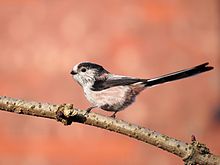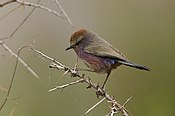
The penduline tits constitute the family, Remizidae, of small passerine birds, related to the true tits. All but the verdin make elaborate bag nests hanging from trees, usually over water.
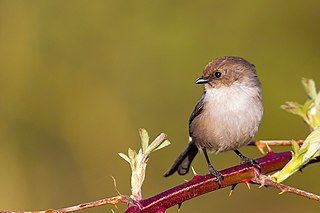
The American bushtit or simply bushtit is the only species placed in the genus Psaltriparus and the only species in the family Aegithalidae that is found in the New World.
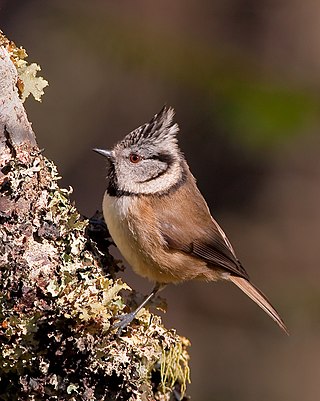
The tits, chickadees, and titmice constitute the Paridae, a large family of small passerine birds which occur mainly in the Northern Hemisphere and Africa. Most were formerly classified in the genus Parus.
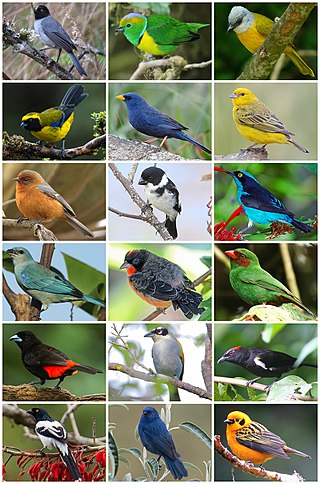
The tanagers comprise the bird family Thraupidae, in the order Passeriformes. The family has a Neotropical distribution and is the second-largest family of birds. It represents about 4% of all avian species and 12% of the Neotropical birds.

The long-tailed tit, also named long-tailed bushtit, is a common bird found throughout Europe and the Palearctic. The genus name Aegithalos was a term used by Aristotle for some European tits, including the long-tailed tit.

The Carolina chickadee is a small passerine bird in the tit family Paridae.

Acanthiza is a genus of passeriform birds, most endemic to Australia, but with two species restricted to New Guinea. These birds are commonly known as thornbills. They are not closely related to species in the hummingbird genera Chalcostigma and Ramphomicron, which are also called thornbills.

The Melanocharitidae, the berrypeckers and longbills, is a small bird family restricted to the forests of New Guinea. The family contains eleven species in four genera. They are small songbirds with generally dull plumage but a range of body shapes.

The Eurasian penduline tit or European penduline tit is a passerine bird of the genus Remiz. It is relatively widespread throughout the western Palearctic. It is migratory in the northern part of its range but resident in the southern part.

The black-throated bushtit, also known as the black-throated tit, is a very small passerine bird in the family Aegithalidae.

Aegithalos is a genus of passerine birds in the family Aegithalidae (bushtits), encompassing majority of the species in the family.

The black-browed bushtit or black-browed tit is a species of bird in the family Aegithalidae. It is found in mid-southern China and sporadically in Myanmar. Its natural habitats are boreal forests and temperate forests. It was formerly considered conspecific with the rufous-fronted tit of the central and eastern Himalayas but is now often regarded as a separate species. Sometimes the subspecies A. b. sharpei of western Burma is also treated as a species.

The crested tit-warbler is a species of bird in the family Aegithalidae. It is found in China and possibly India. Its natural habitat is boreal forest. It generally has a red hint to it and a bit of blue on, or near, its wings. The tail is of an emerald green colour.

Leptopoecile is a genus of birds in the long-tailed tit family Aegithalidae. The genus was once placed in the large family Sylviidae, but analysis of mitochondrial DNA placed it with the long-tailed tits.

The white-browed tit-warbler is a species of bird in the family Aegithalidae. The species was first described by Nikolai Severtzov in 1873. It is resident in the Tian Shan and central China as well as in the Himalayas where it is mainly found in winter. Its natural habitat is boreal forests.

The tit hylia is a species of bird, monotypic within the genus Pholidornis. It is found in rainforests in West and Central Africa. It had been placed in the family Cettiidae, but in 2019 its assignment to a new family, the Hyliidae, was strongly supported.

The pygmy bushtit is a species of bird in the bushtit family Aegithalidae. The species was once placed, along with the rest of its family, with the true tits, Paridae.
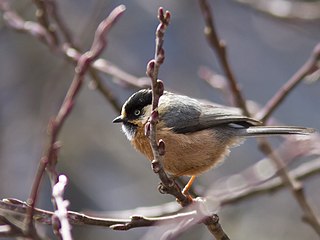
The rufous-fronted bushtit or rufous-fronted tit is a small passerine bird of the eastern and central Himalayas belonging to the long-tailed tit family, Aegithalidae.

The silver-throated bushtit or silver-throated tit is a species of passerine bird in the family Aegithalidae, widespread throughout the temperate forests of Central, East and parts of North and Western China. The bird's native habitats are mainly along the middle/lower Yangtze and Yellow River basins, although there is also a small southwestern habitat extension in Yunnan along the Lancang valley within the Hengduan Mountains. It has two recognized subspecies.
